BBQ pulled pork is the epitome of comfort food. It’s a dish that brings people together, filling your home with a warm, inviting aroma. The key to its delightful flavor lies in the combination of spices like garlic powder and black pepper, and the unique addition of liquid smoke, which imparts a deep, smoky essence to the pork. Cooking it in a pressure cooker not only saves time but also ensures that the meat is tender and full of flavor. This dish is not just a meal; it’s an experience that brings a touch of Southern charm to your dining table.
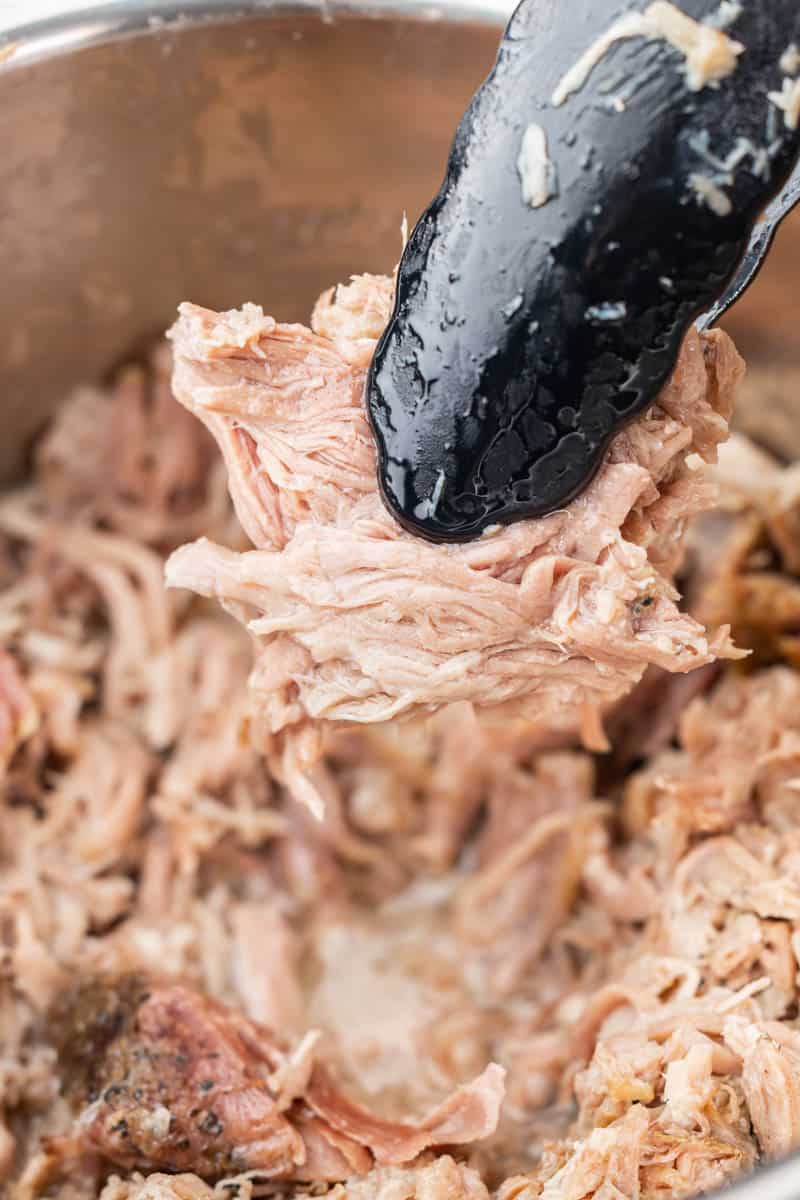
Why You’ll Love Pressure Cooker BBQ Pulled Pork
- Quick & Easy: Minimal prep time, hands-off cooking in the pressure cooker, perfect for busy schedules.
- Flavorful & Tender: The pork is infused with a rich, smoky flavor.
- Versatile: Great for sandwiches, tacos, nachos, or on its own.
- Family-Friendly: Loved by adults and kids alike.
Ingredient Breakdown & Substitutions
- Pork Butt Roast: ideal for its fat content, which ensures tenderness.
- Spices (garlic powder and black pepper): Adds a warm, robust flavor that complements the pork’s natural taste. Feel free to adjust the quantities to taste.
- Hickory Liquid smoke: A key ingredient that imparts a unique smoky flavor, mimicking traditional barbecue smoking methods. Substitute with any other flavor of liquid smoke. Alternatively, a bit of smoked paprika can be a good substitute, although it won’t completely replicate the flavor.
- Worcestershire Sauce (for the BBQ sauce): Can be substituted with tamari or a mix of equal parts soy sauce and apple juice.
Frequently Asked Questions
Absolutely! We included slow cooker instructions in the recipe card so you can choose your preferred cooking method.
While pork butt roast is traditional and favored for its marbling, you can substitute it with pork shoulder if needed.
Any other flavor of liquid smoke will do. It simply adds a smoky flavor to the meat.
Increase the red pepper flakes in the sauce or add hot sauce.
Absolutely, it freezes and reheats well.
Choosing the Best Pork Cut
While pork butt roast is the traditional choice for BBQ pulled pork due to its fat content and flavor, there are other cuts of pork and even beef that can also yield delicious results with this cooking method. Here’s a guide to help you choose the best cut for your BBQ pulled pork:
Alternative Pork Cuts:
- Pork Shoulder (Picnic Roast): Similar to pork butt, it comes from the lower shoulder area. It’s slightly leaner but still has enough fat to stay tender during cooking. It’s a great alternative and often more readily available.
- Pork Loin: Leaner than pork butt or shoulder, pork loin can be used if you prefer a less fatty meat. However, be cautious with cooking times as it can dry out more easily.
Beef Cuts for Pulled Beef:
- Chuck Roast: This is the beef equivalent to pork butt in terms of fat content and texture. It becomes incredibly tender when cooked slowly and is perfect for shredding.
- Brisket: Known for its rich flavor, brisket is another excellent choice for pulled beef. It requires a longer cooking time to break down the fibers and achieve tenderness.
Choosing the Best Cut:
- Look for Marbling: Marbling refers to the white specks of fat within the meat. These fat deposits melt during cooking, making the meat moist and flavorful.
- Consider the Fat Cap: A good fat cap (the layer of fat on top of the meat) can protect the meat during cooking and add flavor. It’s more crucial in leaner cuts like pork loin or beef brisket.
- Size Matters: Ensure the cut fits comfortably in your pressure cooker. Larger cuts can be trimmed or cut into pieces if necessary.
- Personal Preference: If you prefer leaner meat, opt for pork loin or trimmed beef cuts. For more flavor and tenderness, choose fattier cuts like pork butt, shoulder, or beef chuck.
Remember, each cut may require slight adjustments in cooking time or liquid content to achieve the perfect tenderness and flavor for your BBQ pulled pork or beef.
How to Serve Pressure Cooker Pulled Pork
Serve your BBQ pulled pork by itself or on a bun with classic sides like coleslaw, baked beans, or cornbread for a traditional barbecue feel. For a healthier side, consider a green salad or roasted vegetables.
Troubleshooting
- Pork not tender enough? Extend the cooking time by 10-15 minutes.
- Sauce too thin? Simmer it on the stovetop to reduce and thicken.
- Not enough flavor? Increase the spices slightly, keeping the salt in check.
Tips From the Chef
- Natural Pressure Release is Key: Allows the pork to remain tender.
- Shred in the Cooker: Mixes the pork with its flavorful juices.
- Adjust Seasoning: Taste and adjust the barbecue sauce according to preference.
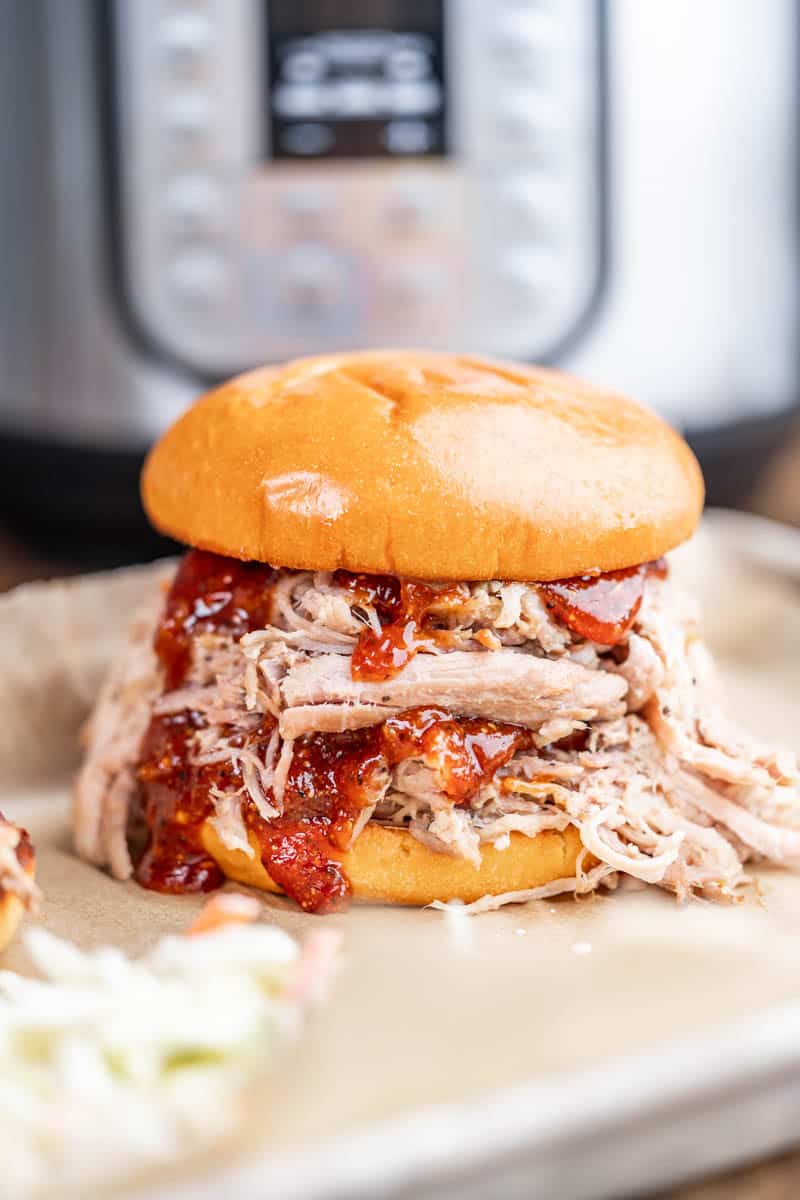
Storage, Freezer & Reheating Instructions
Storage Instructions:
- Cool Down: Allow the cooked BBQ pulled pork to cool to room temperature before storing. This prevents condensation inside the container, which can affect the quality and safety of the meat.
- Refrigeration: Place the pulled pork in an airtight container. If you have a large quantity, consider dividing it into smaller portions for easier storage and reheating. It can be stored in the refrigerator for up to 4 days.
- Separate Sauce: If you’ve made a sauce, store it separately from the meat. This helps maintain the texture of the pork and allows more versatility when reheating.
Freezer Instructions:
- Airtight Containers or Freezer Bags: Use heavy-duty freezer bags or airtight containers to prevent freezer burn. If using bags, remove as much air as possible before sealing. Label each container or bag with the date. BBQ pulled pork can be frozen for up to 3 months.
- Freeze Flat: If using freezer bags, lay them flat in the freezer until solid. This saves space and makes thawing quicker.
Reheating Instructions:
- Refrigerator Thawing: Thaw frozen BBQ pulled pork in the refrigerator for several hours or overnight. This method is safest as it keeps the meat at a consistent, safe temperature.
- Stovetop Reheating: Reheat the pork in a saucepan over medium heat. Add a small amount of water, broth, or additional barbecue sauce to keep the pork moist. Stir occasionally until heated through.
- Microwave Reheating: For smaller portions, reheating in the microwave is quick and convenient. Cover the pork and heat on medium power to avoid drying it out. Stir occasionally to ensure even heating.
Remember, when reheating, ensure the pork reaches an internal temperature of 165°F for food safety. Avoid repeatedly reheating the same portion to maintain quality and safety.
More Pulled Pork Recipes
Slow Cooker Honey-Chipotle Pulled Pork
8 hrs 10 mins
Pulled Pork Nachos
25 mins
Slow Cooker Sweet Pork Tacos
8 hrs 5 mins
Pineapple Chile Pulled Pork Sandwiches
4 hrs 50 mins

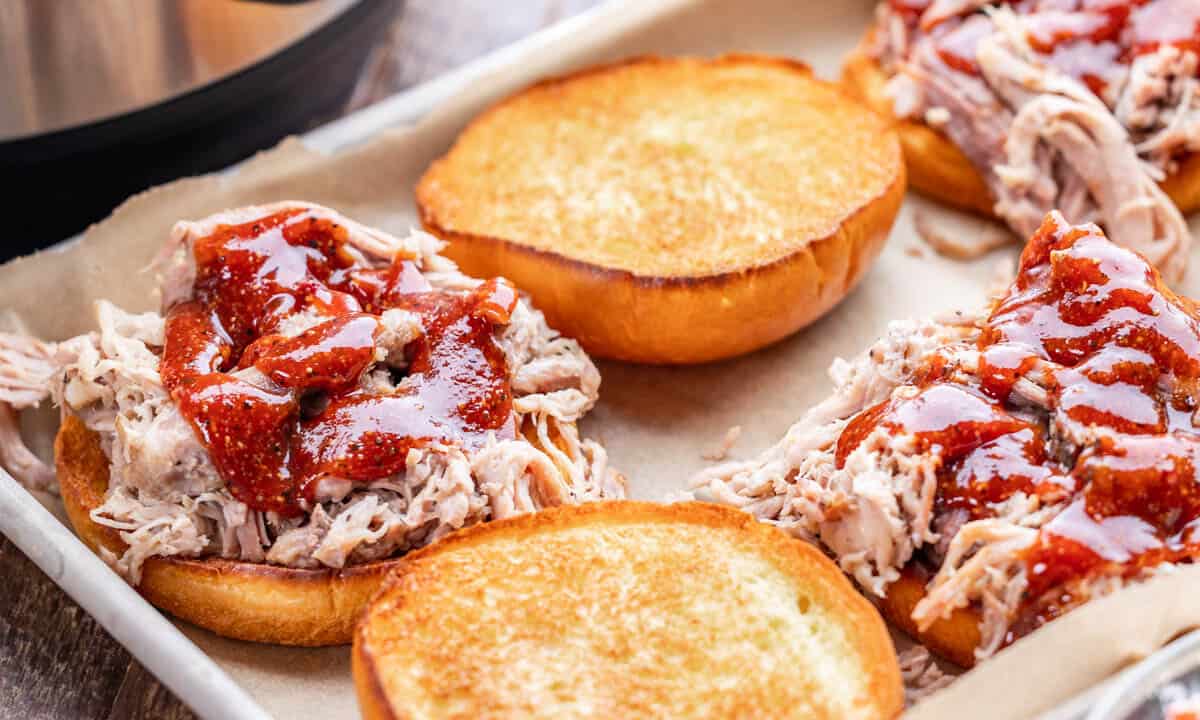
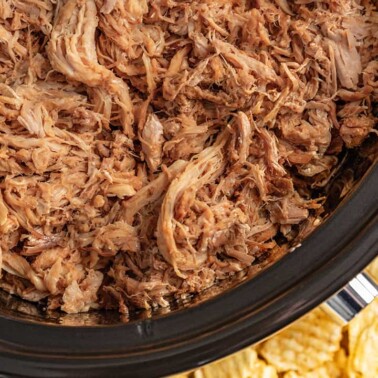
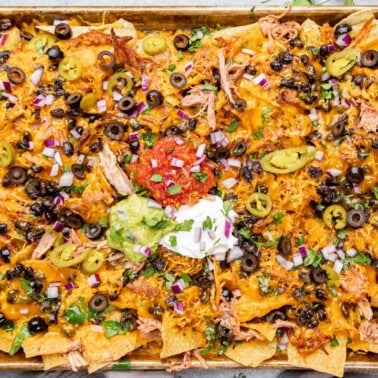
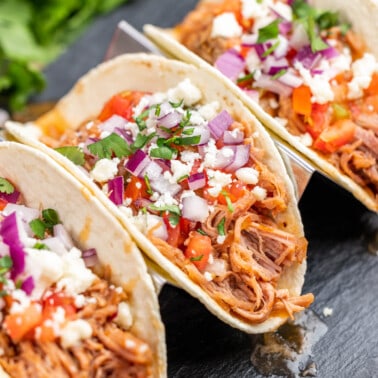
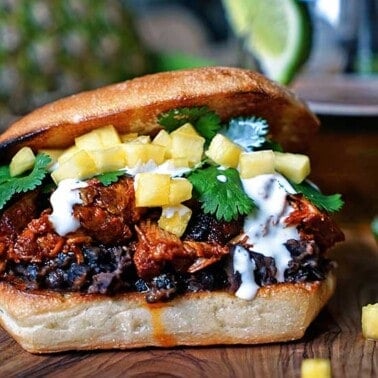
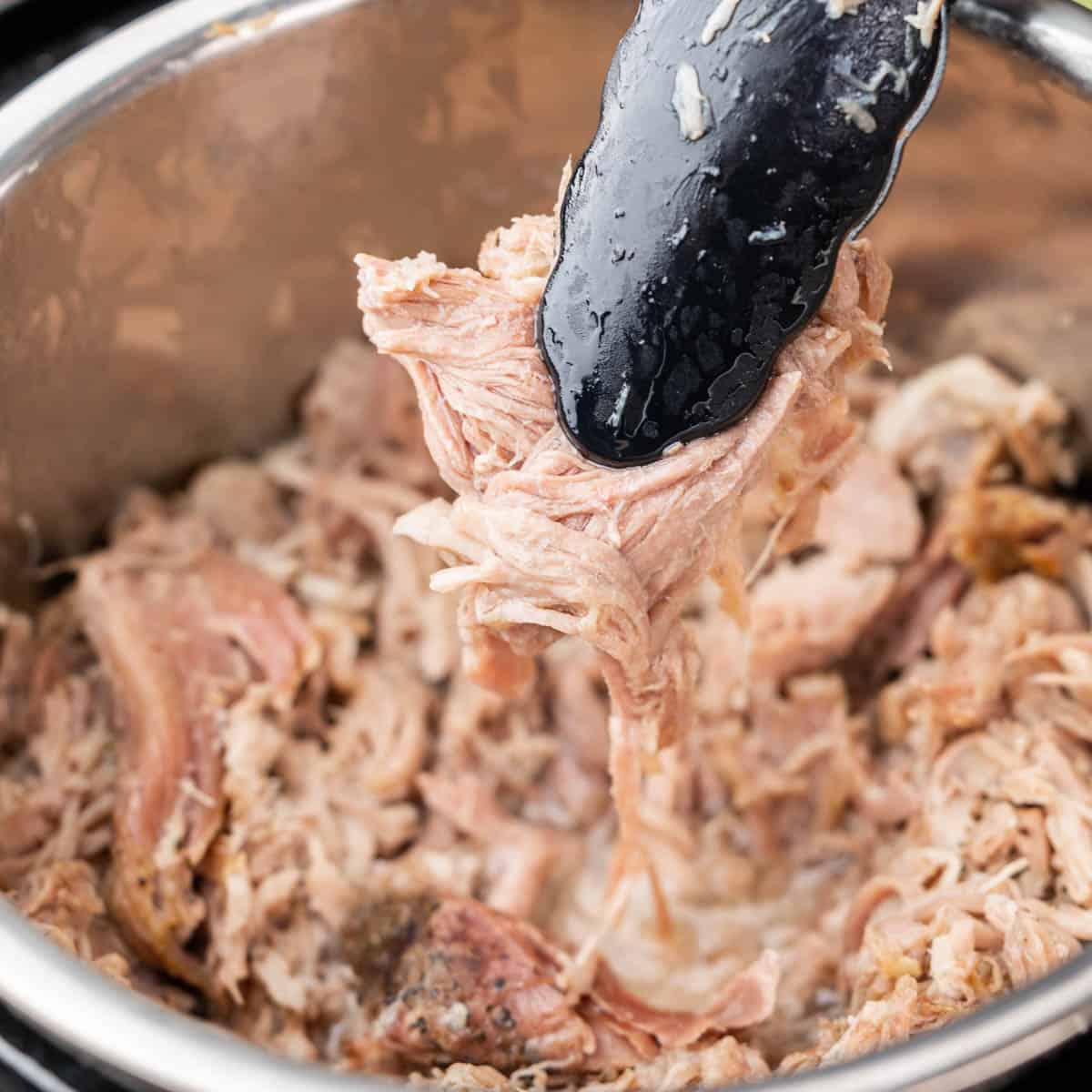
I have an 8lb pork loin. Can I use that instead? Also can I use a dutch oven?
I don’t own a crockpot or pressure cooker
A pork loin is a much leaner cut in comparison to a pork butt/shoulder. It may shred but the final product will be dry. We also have a recipe for how to make it in the oven here- https://thestayathomechef.com/oven-bbq-pulled-pork/